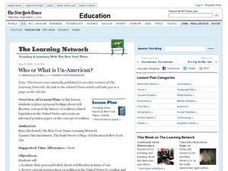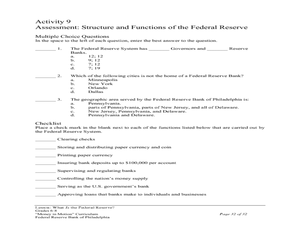Curated OER
Who or What is Un-American?
Students explore concepts about civil liberties, research the history of sedition-related legislation in the U.S. and create a position paper on the topic.
Curated OER
Elbow Room - Exploring Population Density
In this population worksheet, students click on the links and research the internet about population, land, and government. Students answer 16 short answer questions including making spreadsheets.
Curated OER
What Is the Federal Reserve?
Students examine simple bank transactions. In this banking lesson, students analyze banking transactions such as deposits, loans, and how they hold reserves. They participate in simulations of the process of clearing a check and the...
Curated OER
What is a Family?
Students explore how Canadian families have evolved over time. In this census results lesson, students examine the factors that contribute to changing family and household structures. Students also create written and illustrated profiles...
Curated OER
Know Your Local Government
Students explore their local govenment structure and the people who hold various positions of power.
Curated OER
Government: The Mystery Epidemic
Students are able to identify some roles of government in dealing with the prevention and treatment of skin cancer. They are able to list two reasons why the occurrence of skin cancer in youths has increased.
Curated OER
Geography of the Hill
Middle schoolers explore the basic functions of Canadian government, who is responsible for each function and where the officials associated with each function work.
Curated OER
Social Studies: A Quiet Protest
Students examine the protest by Gallaudet University students concerning the hiring of a new school president. They investigate laws related to protests and present their findings to the class in a multimedia show, oral report, or debate.
Curated OER
Social Studies: Bullying Prevention Program
Learners, after researching bullying, develop plans to help younger students combat it. They organize programs to present to learners in lower grades. Students create brochures about bullying to hand out during their presentations.
Curated OER
Imus: How much free speech is too much?
Students read background about Don Imus and his comments about the Rutgers women's basketball team. They explore current interpretation of the First Amendment, including that of commercial speech. Students present the findings to class...
Curated OER
What Are We Going To Do About Baby Six Billion?
Students formulate and evaluate suggestions about government policy using demographic examples and projections. They examine websites and utilize worksheets imbedded in this plan.
Curated OER
Search and Seizure: What Does It Mean?
Students, in a juvenile correctional facility, study the meaning of the Fourth Constitutional Amendment. They study definitions and complete worksheets to investigate the implications of the amendment.
Curated OER
Voters, Ballots, and Elections: Matching
After studying voting and elections in the United States, have your class show what they know. They match 15 terms related to voting, ballots, and elections to the proper definition. This is a great way to practice vocabulary or content...
Utah State Courts
Judges in the Classroom
Class members explore the process of a disposition hearing for juveniles, particularly looking at how the judge decides what sentence the juvenile offender should receive. Task your pupils with evaluating different sample cases provided...
Stanford University
Boston Massacre
The Boston Massacre was a propaganda victory for those protesting British rule over the American colonies. By using images from Patriots, as well as the testimony of witnesses, scholars consider what may have happened on that fateful day...
Digital History
Jeffersonians in Office
If you're looking for a description of the major happenings of the presidencies of both Thomas Jefferson and James Madison, then this is the resource for you. Similar to a textbook reading, this worksheet offers a great deal of...
Reading Through History
The Federalist Papers: Federalist Paper No. 51
How did Federalists feel about the federal government? Learners search for the answers in the Federalist Paper No. 51, which discusses the powers of the presidency. Then, they answer various questions to test for their comprehension of...
Reading Through History
Anti-Federalist Paper No. 3
Who were the Anti-Federalists and what do primary sources tell young historians about their beliefs? Learners read Paper No. 3 to understand their values in relation to government, such as their discussion on foreign policy and the pros...
Curated OER
Citizenship and the Constitution
Students identify government officials and resources on a local, state and national level. They determine the structure of local, state, and national governments.
Curated OER
World History Pre-Assessment
What do the members of your class already know about world history? This is a fabulous pre-assessment that will illustrate the varying levels of general world history knowledge among your young historians that you can use to inform your...
Federal Reserve Bank
The Story of the Federal Reserve: High School Lesson Plan
Is there a bank for the banks? Pupils analyze the complexities of the Federal Reserve system by breaking it down into easy-to-understand sections. Step-by-step investigation using flow charts and graphs of how the monetary system works...
Partnership for Public Service
Presidential Transition Guide
How do two administrations work together to craft a seamless transition of power? Learn more about personnel management, policy implementation, and the role of an outgoing president with a transition plan designed for the 2012...
Foreign Policy Research Institute
Defining Democracy and Freedom
This is a simple but effective introduction to democracy. It requires the class to generate working definitions of key terms (provided) and to determine the degree of democracy in various geographic locations today. After they conduct...
National Endowment for the Humanities
George Washington: The Precedent President
Everyone knows that George Washington was the first president, but do your scholars know why that was so important? The lesson plan, the third in a sequence of three, allows learners to understand how George Washington set a precedent...

























